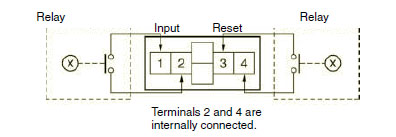Question
What do the input conditions that are specified in the data sheet for "no-voltage input" mean?
Answer
A no-voltage input is a count input from the open collector of a transistor or from a contact to the input terminal.
1. No-voltage input
Example: Using the H7EC-N
Maximum short-circuit impedance: ON at 10 kΩ max.
Short-circuit residual voltage: 0.5 V max. (actual power: 1.0 V)
Minimum open impedance: OFF at 750 kΩ max.
(1) Contact Input (from a Relay or Switch Contact)


Figure 1. Contact Input
Note: Use Relays and Switches that have high contact reliability because the current flowing from terminal 1 or 3 is small. OMRON's Solidstate Relay the G3TA-IA/ID should be recommended for the SSR use.
(2) Transistor Input (from an Open Collector of an NPN Transistor)


Figure 2. Transistor Input
Note 1: The residual voltage in the output section of Proximity Sensors or Photoelectric Sensors is small (less than 0.5 V) because the current flowing from terminal 1 or 3 is small, thereby allowing easy connection.
Note 2: Select transistors (Tr) according to the following formulas:
Dielectric strength of the collector ≥ 50 V
Leakage current < 1μA
2. Maximum Short-circuit Impedance
This term refers to the resistance value that is used to detect when the input to the Counter is ON.
(In figure 1, the input is detected as ON when the resistance value between terminals 1 and 2 is 10 kΩ max. when the input is turned ON.)
3. Short-circuit residual voltage
This term refers to the voltage that remains in both transistor terminals when an input turns ON. (See Figure 2.)
When using the H7EC-N, the short-circuit residual voltage is 0.5 V max (actual power: 1.0 V), so select a model with a residual voltage (voltage drop when output is turned ON) of 0.5 max, for the input device in figure 2.
Note:If the residual voltage is the same as the specified voltage or higher, ON signals can not be detected, preventing normal operation.
4. Minimum Open Impedance
This term refers to the resistance value used to detect whether the input is an OFF signal.
If the impedance of the input device is the same as the specified value or lower, the OFF signal will not be detected and the input will remain ON, resulting in abnormal operations.





